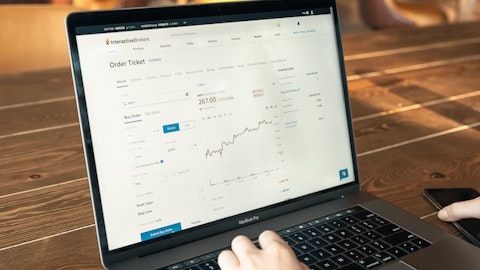Global Blue Group Holding AG (NYSE:GB) Q4 2023 Earnings Call Transcript June 28, 2023
Jacques Stern: Good morning. I am Jacques Stern, the CEO of Global Blue. And I will today present the Fiscal Year Results ’22-’23 with Roxane Dufour, CFO of Global Blue. Before I leave the floor to Roxane, let me first give you the key highlights of this results for ’22-’23. First, happy to report significant improvement of the adjusted EBITDA at €78 million versus minus €10 billion last year, which represent 46% of 2019-2020 fiscal year. Second, we have a healthy balance sheet with a strong position of cash of €240 million at the end of March ’22-’23. Third, we have noticed an acceleration of the recovery in April and May ’23. More in detail in my presentation, but two figures, which are important in Continental Europe, recovery has now reached 115% versus 109% in the last quarter of our fiscal year, so from January to March.
And in APAC, the recovery has now reached 104% in April and May versus 87% in Q4, of our fiscal year ’22-’23. Beside the current level of recovery that I have just exposed Global Blue will further benefit from Mainland China reopening which is only started. And from that point of view, I will come back on the simulation that we have made, which if we basically take the extrapolation on 12 months over Q4, and we simulate 125% recovery of Chinese, then the Group will reach over €200 million. I will come back on that. Last but not least, beside this current rate of recovery, and the expected one, thanks to the Chinese, Global Blue should benefit from strong long term driver. I will come back on that and is well hedged against the risk of inflation and Europe recession.
With that in mind, I now leave the floor to Roxanne.
Roxane Dufour: Thank you, Jacques. I am Roxane Dufour, the CFO of Global Blue and I will take you through the Group’s financial performance for the quarter four and the full year ended on the 31st of March 2023. Again, a reminder that our financial year runs from April to March. And this is our Q4 full year result announcement. And all the reconciliation to the nearest IFRS metrics are included into the appendix. So let’s move now to Slide 8 for the Adjusted P&L related to our Q4. We are pleased to report a significant improvement across all the key metrics, TFS and AVPS, reported sales-in-store increased by €2.9 billion and is now at 116% of Q4 ’19-’20. Group revenue is now at 105% of Q4 ’19-’20. And turning to adjusted EBITDA, we have delivered a significant improvement to €21.3 million euro which is at 82% versus Q4 in ’19-’20, versus use in Q3, 56%; 42% in Q2; and 17% in Q1.
So significant improvements quarter-on-quarter during the year. Finally we recorded an adjusted net income for the Group of negative €1 million, again, a significant improvement compared to last year where we were at negative €16.4 million. Now let’s turn to Slide 9. Here we are showing the revenue profile over the last eight quarters and we can see a strong improvement quarter-on-quarter. Starting with TFS, there has been a strong quarterly improvement for 47% recovery in Q1 to 88% in Q4 versus the same period in ’19-’20. The increase in revenue primarily reflects the air traffic recovery and the increase in average spent of international shoppers. Turning now to AVPS, we can also see here a strong improvement with revenue increasing from 79% recovery in Q1 to 151% in Q4 versus the same period in ’19-’20.
Finally, RTS; RTS delivered a significant increase in revenue versus the same period last year, reflecting a strong organic growth from ZigZag and Yocuda. And the €1.2 million scope effect from ShipUp. As a reminder, RTS is a combination of three companies; ZigZag acquired in March 2021; Yocuda, consolidating in September ’21, and the recent acquisition of ShipUp in November 2022. Turning now to Slide 10, where we demonstrate all Issued SIS recovery translate to revenue recovery. This is a bridge detailing a number of items to consider between the issued SIS and the reported revenue. Here we are showing the comparison versus Q4 ’19-’20 and Q4 ’18-’19. I will comment on Q4 ’18-’19, which is equal to the first quarter of the calendar year 2019.
As Jacques will refer to those number later in the presentation. We are at 111% recovery for issued sales-in-store in AVPS and TFS. The issued SIS is presented on a like-for-like basis, meaning at constant parameters. Then we take into account the scope effect of the UK abolishing the Tax Free Shipping Scheme in January 2021. As a reminder, prior to the abolition of the scheme, the UK accounted for around 14% of Group TFS reported which is no longer the case here. The impact from the UK Abolishment is 12 points and there is a further impact seven points related to FX transaction and one point impact related to the discontinuation of our TFS business in Russia, which give us at the end 91% recovery in issue SIS reported in TFS and AVPS, effectively 82% for TFS, 127% For AVPS.
Then we have the refund ratio. Once the transaction is issued the traveler has to validate the tax reform and get the refund. This is at this point in time the transaction is part of the reported SIS which triggers the revenue. Today the actual refund ratio is slightly lower than Q4 ’18-’19, and this is mainly due to nationality mix effect. Then they have transactions completed off period. This is where transactions are issued in a quarter and validated, refunded in the following quarters. This gets us to 90% recovery for completed SIS in TFS and AVPS. Then we have some leakage from completed reported SIS is to reported revenue. First for TFS, we have a merchant mix effect where there has been an increased level of business with larger merchant, luxury merchant who get a higher rate of commission.
We then have an increase in the average spend, which means more VAT refunded and therefore a lower level of commission for Global Blue. Second, we have the AVPS mix effect, where the AVPS business with a lower margin is growing faster than TFS. This gives us 80% of reported revenue recovery for AVPS and TFS. Finally, we have the contribution from RTS business, which gives us at the end 87% revenue recovery for the quarter for the Group. Turning now to Slide 12, for detailing the full year financial year performance. As with Q4 we have seen a significant improvement across all the key metrics for the full year. Total Group revenue is now at 74% of ’19-’20 levels. This increase in revenue reflects the air traffic recovery and the increase in the average spend of international shoppers.
Turning to adjusted EBITDA again a significant improvements €78 million which is 46% of ’19-’20 level. The improvement is due to significant increase in revenue and the continued strong focus on the cost base. Finally we recorded a negative adjusted net income for the Group of €8.1 million, a significant improvement versus last year where we were at negative €69.5 million. Turning now to Slide 13, for an overview of the adjusted operating expenses. The variable costs were reduced by 27% versus a revenue decreasing of 61% in AVPS and TFS, so inline. Besides the volume driven cost reduction, there has been a reduction of 18% to €28.4 million of adjusted fixed operating expenses as a result of the cost savings program implemented in 2021.
This is despite €4.3 million of listing costs, which we didn’t have in ’19-’20. Then we have the inflation which has negatively impacted the fixed cost by more than €10 million, which is around 7%. And finally, we show the scope effect of RTS for a total of €26.8 million. So excluding listing cost, inflation and the scope effect of RTS, fixed costs have reduced by around €33 million in line with our original guidance of €35 million. Turning now to slide 14, for a summary of other costs. D&A decreased to €36.7 million as a result of the reduced level of CapEx during the past two years. Then net finance costs, costs increased by €12 million to €36.6 million for a number of reasons. First, the increase of the Euribor rate related to the senior debt triggered an annual impact of almost €7 million.
Second, the interest cost for €1.7 million related to the drawdown of the supplemental shareholder facility in April ’22. Third, €2 million costs related to the unhedged open position in the balance sheet. And finally €1.2 million foreign exchange losses related to the Certares, Knighthead equity transactions denominated in USD while Global Blue report in Europe. Now let’s move to Slide 15, for an analysis of the cash flow. After an adjusted EBITDA of €78 million, the level of CapEx was around €34 million in financial year ’22-’23 and is essentially related to technology development. Global Blue, as a reminder Global Blue is a low capital intensive business. It’s very pleasing to report a positive adjust EBITDA less CapEx of €44 million while we continue to invest in strategic projects.
Turning now to working capital. Our volume increase, being correlated with the [indiscernible] recovery. That leads to an increase in our working capital needs as traveler get the refund upfront and about a month later we collect the VAT from the merchant or the authorities. So our working capital increase as business volume increase and is highest during the summer season, which is the peak season since passenger volume tend to increase during the summer holidays. And as a reminder, our networking capital outflow at the end of September was €87 million this year. Similarly, our working capital decreased rapidly just after the summer season. So during the what we call the low season, during the winter, and it released the working capital that has been built during the summer.

Pixabay/Public Domain
And here there is a decrease of about €49 million versus the summertime, resulting at the end of the year an outflow of almost €40 million for financial year ’22-’23. Finally with the proceeds from the issue of share capital from Certares and Knighthead equity investments, our net financial debt decreased by €127.5 million, which I’ll cover on the next slide. As of 31 of March, 2023, our net financial debt amounted to €550 million. Both our senior debt and revolving credit facility for a total of €729 million have a maturity date of 28 of August 2025. As a reminder, the first testing for the financial covenant was on 31 of March 2023 and the total net leverage must be lower than 0.75 times. We were in compliance with this testing with total net leverage at the end at two times.
So you can see we have significant restraints on our balance sheet. And now we have almost €240 million of cash and cash equivalents and have reduced debt by €128 million as a result of the Certares, Knighthead equity investments, and our continued strong focus on the working capital. Turning now to Slide 17, for the key takeaways. To conclude, first, we are pleased to report a significant increase in revenue of 257% this year versus last year with TFS and AVPS revenue at 74% of ’19-’20 level. Second, thanks to the strong revenue growth and strict management of the cost base, we are pleased to report a strong improvement in adjusted EBITDA to €78 million this year from negative last year at €9.9 million. Now the EBITDA is at 46% versus ’19-’20.
Third, our savings program implemented in 2021 continued to deliver and our fixed adjusted operating expenses, excluding the scope effect of RTS and inflation have reduced by 18% versus ’19-’20. Finally, we have a strong cash position with around €240 million of cash and cash equivalents as the result of decentralized investment and our continued focus on the working capital. So this concludes the financial sections. I will allow me over to Jacques to present the latest tax free shopping trends and the long term cost driver for Global Blue.
Jacques Stern: Thank you, Roxanne. So latest trend. So as mentioned in my introduction, you see that April and May have shown an acceleration versus Q4. So namely on like-for-like basis, we have reached 112% of the recovery, which shown 11 point of increase versus Q4. And if we go into the detail it’s basically a 6 point increase in Europe and 17 point increase in APAC. I’ll come back to that in a minute. If we take into account, as mentioned by Roxanne, the impact of the abolishment of tax free shopping in the UK and the same perimeter of merchants, we are almost reaching in April and May 100% of 2019-2020, at 99%, which show there also an improvement of 11 point versus Q4, which was at 88%. So if we go into the detail and we start by Continental Europe as a destination, you can see that April and May have shown 115% level of recovery with May being very strong at 121% in particular on the back of a good season of post [indiscernible] in Continental Europe.
If you look to the right part of the chart, you’ll see that, as we had seen in the last two quarters, the tax free spend over 115% level of recovery is boosted by an increase of average spend of 25% whereas the level of recovery of the international shoppers is now at 92% in this two months. If we look now, in the detail of the nationality in terms of origin market, we continue to see very strong performance of the American. In May and April the average was 260% level of recovery versus ’19, which basically is in line with the Q4, like we have seen for the GCC. So more than 200% slightly affected by [indiscernible], which was in April, but totally they’re also in line with the average of the year. Obviously beside that those two nationality I think what is important to look in this chart is that the recovery of all nationality excluding China, Mainland China and Russia is now at the level of 153%, where, and we’ll come back to that in a second, we see Mainland China, continuing the gradual progression, now at 45% in April and May versus 31%, in Q4.
Russia being still at 20%, and with no light of any further recovery. Coming back to the Chinese, you can see that April and May have been consistent around 45%. And in terms of main destination for Chinese in Europe, you can see that it was led by France and Switzerland, which are now above 50%. If we turn to APAC as a destination, they also we have seen months of May, which has been stronger than the month of April 110%, for an average of 104%. And there also we have seen that this performance is boosted by the increase of spend, which is more or less equivalent in Europe, slightly higher, 29% with an international shopper recovery, which is now in APAC for April and May at 81%. If there also we go to the detail per nationality, we have seen that all nationality excluding Mainland China, are now at the level of 176%, which is an increase of almost 14 points, versus the last quarter, with in particular very strong performance from Hong Kong and Taiwan, which is still around 360% of 2019.
But what is more meaningful for APAC is really the continuous improvement of Mainland China. They represented 56% of 2019 total SIS. So very strong contribution. And you can see that the increase has been strong 18 points during the month of April, May versus Q4, and we are now reaching 52% with 60% in particular in the month of May. You see that in the detail. So you see the 60% for May versus 44% for April for Chinese going into APAC as a destination. And if you look on the right, in particular, you see the very strong performance of South Korea, and Singapore. South Korea being already above 2019. Japan is still, I would say lagging the recovery. But clearly, with the reopening in the month of May of the full border, with the flight now being fully, I wouldn’t say back to normal in terms of capacity, but at least the number of airports being enlarged, we can expect an improvement of the Japan performance in the next coming months.
So in summary, and this slide show you the performance, both for Europe and in APAC, with and without China and Russia. You see that for Europe and for APAC, we are now well above 150% if we exclude Mainland China and Russia, and we have seen a continuous improvement in the last months in terms of recovery. And starting in January with the reopening of China, we are seeing now that China is also recovering, still at a low base, because we had 39% for Mainland China and Russia and Europe and 52% in APAC. But it’s gradual and it’s progressive. Let me give you more colors on, in particular the Chinese which clearly is the main driver for ’23-’24 in terms of further acceleration of recovery. And there clearly there’s a couple of good news that we are noticing.
First, the willingness of Chinese to travel and shop abroad is important. You see on the chart of the page 29, that it has improved in the last few months, and in May, we are not — the willingness is now at 83%, which show really an important potential uplift of the business, specially during the summer, which is really where the Chinese intend to first travel back abroad, in particular in APAC, but also in Europe. The second good news in terms of Chinese is that, like many other nationality there had been a lot of saving during the COVID time. And for China, you may, you may remember that it was three years. We are talking about more than €2.1 trillion, which has been saved during this period, which are ready to be spent on a lot of things, and in particular, on luxury good, because during those three years, in average Chinese reduced their spending in luxury goods of around €30 billion to €35 billion, which means that on top of the annual spending of around €100 billion, you have another kind of 100 billion of saving, which are ready to be spent.
So we have really two good news which is one, they are willing to travel and to shop again, but also they have a purchasing power, which is much more important than pre-COVID. And we are seeing that already in terms of spent because we see average spend, which are higher, for Chinese compared to 2019. But it will be a gradual ramp up. Why? Because there’s some constraints to the travel first, in terms of visa and passport. Not all the Visa Center in China, for Europe, in particular are back to normal. We are still around 50% to 60% of the capacity pre-COVID. We see that there’s a time lag to get those visa, which is around — between one and three months, depending on the country. So if simply you want to travel during October, you need to do it now, if you want to get your visa on time.
And obviously which is the object of this slide, we are also still seeing some air capacity constraints. For the month of May, the recovery was only 41% to go in Europe for Chinese and 38% to go in APAC. But the good news is that progressively, we are seeing this capacity being extended. During summer, the expectation is to be around 50% to 55%. So namely 54% in Europe and 50% in APAC and to be able to reach for the autumn something around 75%. So by definition Global Blue will benefit from that. This chart, page 32 try to explain what is the level of benefit for Global Blue of China. If I want to be very simple, and I’ll go back to more detail after, every time that the recovery of Chinese increased by 1%, we have a positive impact on our EBITDA which is slightly lower than €1 million.
You may remember that pre-COVID Chinese represented 40% of our sales in store. So very strong in that which is shown on this chart. So let me explain to you this chart, which is probably the most important of the presentation. So if I start first, on the left side with the dark blue bar, these represent the last 12 month at the end of 2019 level of EBITDA. So concretely on the calendar year 2019, so without any impact of COVID-19. The Global Blue Group reached an EBITDA of €187 million with a margin, EBITDA margin of 42.8%. If we position our self in the light blue bar, this represent our fiscal year 1920. So ending in March 2020, already with an impact of the month and a half of COVID, in particular in APAC. And you see that this had cost us at the time €17 million of EBITDA, namely an EBITDA of €170 million.
And if you go on the top of the chart, you see that this would — in March, this will — had implied a 93% level of Chinese revenue versus the calendar year 2019. And at the Group level, revenue, which was 96%, of 2019 calendar year. The third column is about our last quarter, so quarter four of our fiscal year ’22-’23. So January to March ’23. And we have their simulated on the based on the quarter four, what would imply the current the quarterly results, i.e. €129 million of EBITDA. So to be compared to the €78 million that we have published, but obviously, this is the combination of the year. But if we take only the quarter four and we basically simulate that on the full year, it’s €121 million. Implied in this €121 million of EBITDA 20% recovery of Chinese and a total recovery as shown by Roxane of 79% on quarter four.
So now if we turn on the right side of the page, and if we are looking to some simulation of potential recovery of revenue for Chinese you see that for example, if you take the 125% mark, which is not unthinkable when you think about the GCC or the U.S. recovery, you see that this would imply a revenue recovery at the Group level of 105% and an EBITDA of 215% with a margin of almost 47%. So in summary, as I was mentioning, China is key for Global Blue EBITDA in ’23-’24. And just keep in mind, for every point of recovery, it’s almost €1 million of further EBITDA. Besides that, obviously, Global Blue has long term driver. So clearly, we are benefiting from the recovery of all nationality in 2022-2023, but now, we are benefiting from China. But after the 18, 24 months of Chinese recovery, what shall we expect for Global Blue as a long term driver.
So four elements to have in mind First of all, Global Blue through the tax free business we are in, is in a business which basically is growing is growing at double digit at least between the last 10 years before COVID. And the reason why is basically the fact that 80% of our business is about luxury spend and the luxury business in itself has a significant growth. So before COVID, it was for domestic consumption of luxury, around 5.8%, and during the same period, the TFS market has grown of 10%. So why this 4.2% of premium, of tax free growth versus the growth of domestic luxury, mainly two reasons, one, because 70% of the underlying business is coming from emerging markets in tax free shopping and this market basically benefit from the increase of middle class household number.
And before COVID it was 10% increase. So we as TFS are benefiting from this increase. Very simply, more middle class average income leads to more people who want to travel and also more people who wants to travel abroad. Second reason which explain this premium over tax free shopping versus domestic luxury is because 25% of the consumer base is high net worth individual. And there also this group of people have grown in the 10 years before COVID at the level of 9%. So in summary, tax free shopping is a business which has grown by 10% before COVID because of this emerging market dynamic, but also the high net worth, individual dynamic. The second element to have in mind when you think about the long term growth of Global Blue is the expansion of the scheme.
To give you an idea, seven countries has been open in the 10 years before COVID. And this has contributed to an increase of 2% of our volume, so sales in store from 2010 to 2020. And there’s more country, which have VAT scheme, but no VAT refund, as you can see on the slide. Only brackets [ph] 72 country today have a VAT refund scheme, and among the 181 which have adopted VAT there is today almost 110 which have not the VAT refund scheme. So more country to be opened in the future, which is one of the driver for groups. The third element is about digitalization and this is true for the payment. But also this is true for tax free business. Basically there after 40 years of being present in this industry we have only a penetration of 52%. So 52% of the potential issued volume is currently refunded.
So it’s a great opportunity and how to make that possible clearly by digitalizing, and making more simple the consumer experience. To give you two figures, when we are looking to digital country like France, like Spain, like Italy, we see that this penetration is 55% where when we compare it to the penetration in country which have not been fully digital, it’s only 42%. So digitalization is clearly an element, which will contribute to the growth of Global Blue. And if we look back to the 10 years before COVID, this has also contributed to 2% sales in store growth. So in summary, three very important leverage for tax free and digital also for payment. And last but not least, e-commerce dynamic. You know that we have bought recently three company, which are in the space of the e-commerce.
And from that point of view, the expected growth of 10% of the e-commerce will benefit to the company that we had bought in that space. Last but not least, obviously, always the question of what about inflation and potential recession risk on Global Blue? From that point of view, I would say that in both cases were well eight. If we start by inflation, you can see that the luxury brands have increased at a higher speed in the last four years, their price versus the general inflation, something like seven point and as our revenue is directly indexed on the spent of luxury goods we benefit from this increase, which is more important on luxury goods than the general inflation. On the other hand, if we think about a recession in Europe, you can see on the right, we have indicated you what was the performance of Global Blue during the last strong great recession in 2008-2009.
And you see that at that time we were capable to post a flat result in terms of volume, which was much better or then the impact of luxury, which in the same period have decreased the revenue by 8%, and obviously, much better than the travel industry, which had a severe drop in their revenue of 16%. So in summary, Global Blue is well hedged against the risk of inflation or European recession. So let me conclude with the key takeaway, as mentioned by Roxane, a significant improvement of the EBITDA at €78 million versus minus €10 million last year, in particular, thanks to a very strong Q4 cash position which is strong, with €240 million at the end of March 2023. And acceleration of the recovery that we have seen in April and May versus Q4, obviously boosted by a gradual recovery of Chinese but we are expecting this recovery from Mainland China to further continue during the summer.
And if we simulate €125 million Chinese recovery, then the Group can reach above €200 million based on the simulation over the Q4 level of recovery. And last but not least, after those 18 to 24 months of benefiting from the Chinese recovery. Global Blue is well prepared to have further long term driver, as I’ve mentioned. And then also as mentioned, we are well hedged against the risk of inflation and Europe recession. So that’s end the presentation of our fiscal year ’22-’23. And I give you rendezvous for another quarter at the end of August. Thank you very much.
See also 35 Safest Countries In the World and 25 Poorest Cities In The US That Are Getting Poorer.
Q – :





